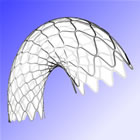|
The one-year results of TWENTE, presented by principal investigator Dr. Clemens von Birgelen, MD PhD, showed virtually no differences in the two stents in all primary and secondary end-points of both safety and efficacy. These results mirror the RESOLUTE ALL COMERS trial presented earlier this year at the American College of Cardiology annual meeting, although the actual results in TWENTE were a bit better. According to Dr. Birgelen, these better results may be due to the high rate of post-stent dilatation, around 80%. Post-dilatation is a technique that was first discussed 20 years ago by Antonio Colombo when he showed, using intravascular ultrasound (IVUS), that most implanted stents were underexpanded -- and therefore not optimally placed. IVUS is still only used in a minority of procedures worldwide, mainly due to reimbursement issues. The Xience has virtually replaced the use of 1st generation DES worldwide with better outcomes and lower stent thrombosis rates. It has been available in the U.S. since July 2008; the Resolute has a CE Mark in Europe and Medtronic has submitted the stent to the FDA and is hoping for approval sometime next year. The TWENTE study will no doubt support that application. One question in the RESOLUTE ALL COMER trial was that there was a small clustering of early stent thromboses in the first 30 days. As Dr. Alan Yeung told Angioplasty.Org, that was most likely due to incomplete antiplatelet treatment immediately post-procedure at a couple of the study centers (five of the events occurred on day 0). The RESOLUTE US trial saw no such issues, nor does the TWENTE trial, putting that small concern to rest. Assuming Resolute gains FDA approval, physicians in the U.S. will have a choice of two very similar stents and, as Dr. Ron Waksman of the Washington Hospital Center commented to us, physician choice may come down to pricing, availablility of stent sizes and personal preferences. The patients enrolled in TWENTE were "real world" with very few exclusions: 82% of patients who were eligible were enrolled, 25% bifurcations lesions, 21% diabetics, NSTEMI -- in all 78% of patients had "off-label" characteristics. And the followup was 100% (Dr. Birgelen told us that his staff actually traced patients to Asia and Africa to get this perfect followup figure). All in all, the result of this trial is very good news for patients in that the new generation of drug-eluting stents have extremely good outcomes and very very low stent thrombosis rates. TVF at one year occurred in 8.2% of patients for the zotarolimus-eluting stent, and in 8.1% of patients for the everolimus-eluting stent (p=0.94). For the components of the primary endpoint, there were also no significant differences: cardiac death (1.0% vs. 1.4%, p=0.46), target vessel-related myocardial infarction (4.6% vs. 4.6%, p=0.98), and clinically driven target vessel revascularization (3.3% vs. 2.7%, p=0.53). TWENTE showed similar and – considering the complexity of the patient population and the lesion characteristics – relatively low one-year rates of definite-plus-probable stent thrombosis for the zotarolimus and everolimus-eluting stents (0.86% and 1.16%, respectively). TWENTE also showed a low definite one-year stent thrombosis rate for zotarolimus and everolimus-eluting stents (0.58% and 0%, respectively). Reported by Burt Cohen, November 11, 2011 |

